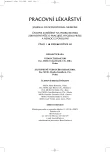Syndrome of Obstructive Sleep Apnoea and Health Ability to Work
Authors:
M. Hobzová 1; M. Nakládalová 2; V. Kolek 1
Authors‘ workplace:
Klinika plicních nemocí a tuberkulózy FN a LF UP Olomouc, přednosta Prof. MUDr. Vítězslav Kolek, DrSc.
1; Klinika pracovního lékařství FN a LF UP Olomouc, přednostka Doc. MUDr. Marie Nakládalová, Ph. D.
2
Published in:
Pracov. Lék., 60, 2008, No. 1, s. 17-21.
Category:
Review article
Overview
The aim of the paper is to present the basic review information on the syndrome of obstructive sleep apnoea which is more frequently diagnosed and treated in relation to the increasing number of sleep laboratories in the Czech Republic. The paper draws attention to relations between the disease and the sleep, however their consequences may affect also the vigilant state and may influence the working capacity of the patient due to hypersomnia and micro-sleep. The authors present a few of short case studies which point out to this disease as an important fact in assessing the health ability to work.
Key words:
obstructive sleep apnoea, microsleep, traffic accidents, hypersomnia, health ability to work
Sources
1. ŠONKA, K. Apnoe a další poruchy dýchání ve spánku. Praha : Grada, 2004, s. 63–191.
2. STRADLING, J. R. Handbook of sleep-related breathing disorders. Oxford : Oxford University Press, 1995.
3. ERLER, T. Grundlagen und Praxi der Schlafmedizin fur Medizinisch-Technische Assistenten. Munchen: Dustri Verlag. Dr. Karl Feiste, 1999, s. 39–94.
4. REDLINE, S., TISHLER, P. V., TOSTESON, T. D. et al. The familiar aggregation of obstructive sleep apnea. Am. J. Respir. Crit. Care. Med., 1995, 151, s. 682–687.
5. GUILLEMINAULT, C., PARTINEN, M., HOLLMAN, K. et al. Familial aggregates in obstruktive sleep apnea syndrome. Chest, 1995, 107, s. 1545–1551.
6. CARMELLI, D., COLRAIN, I. M., SWAN, G. E. et al. Genetic and environmental influences in sleep-disordered breathing in older male twins. Sleep, 2004, 27, s. 917–922.
7. CASSEL, W., PLOCH, T., BECKER, C. et al. Risk of traffic akcident in patiens with slep disordered breathing: reduction with nasal CPAP. Eur. Respir. J., 1996, 9, s. 2606–2611.
8. PALMER, L. J., REDLINE, S. Respir. Physiol. Neurobiol., 2003, 135, s. 187–205.
9. TKÁČOVÁ, R. Spánkové apnoe a ochorenia kardiovaskulárného systému. Galén, 2006, s. 113–122.
10. PALOMAKI, H. Snoring and the risk of ischemic brain infarction. Stroke, 1991, 22, s. 1021–1025.
11. CUTLER, M. J. et al. Sleep apnea:from the nose to the heart. J. Am. Board Fam. Pract., 2002, 15, 2, s. 128–141.
12. BIXLER, E. O. et al. Arch. Intern. Med., 2000, 160, s. 2289–2295.
13. DIEMSDALE, J. E. et al. Effects of continuous positive airway pressure on blood pressure. A placebo trial. Hypertension, 2000, 35, s. 144–147.
14. KERN, J. C., KUTLER, D. I., REID, K. J. et al. Laser-assisted uvulopalatoplasty and tonsillectomy for managment of obstructive sleep apnea syndrome. Laryngoskope, 2003, 113, 7, s. 1175–1181.
15. VYSKOČILOVÁ, J. Syndrom spánkové apnoe – diagnostika a léčba. Kasuistiky v alergologii, pneumologii a ORL. 2007, 4, 2, s. 19–23.
Labels
Hygiene and epidemiology Hyperbaric medicine Occupational medicineArticle was published in
Occupational Medicine

2008 Issue 1
Most read in this issue
- Syndrome of Obstructive Sleep Apnoea and Health Ability to Work
- Follow-up of the Most Serious Stages of Vascular Diseases Caused by Vibrations at Machine and Smelting Works
- Development Trends of Professional Dermatoses in the CR in 1992–2004
